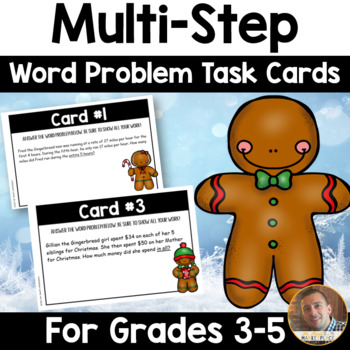Gingerbread Multi Step Word Problem Task Cards FREEBIE Fourth and Fifth grades
23,430 Downloads
Mr Mault's Marketplace
18.6k Followers
Grade Levels
3rd - 5th
Subjects
Resource Type
Standards
CCSS3.OA.C.7
CCSS3.OA.D.8
CCSS3.OA.D.9
CCSS4.OA.A.1
CCSS4.OA.A.2
Formats Included
- PDF
Pages
6 pages
Mr Mault's Marketplace
18.6k Followers
Description
This set of 4 task cards focuses on the concept of multi-step multiplication word problems, (4.NBT.6). These cards are Gingerbread themed, which I used in my holiday rotation day, which will be sure to engage students!
Perfect for math centers, small group math, or just a general review and practice of multiplication using the distributive property and multi-step problem solving.
Thanks for looking,
Dan M.
Total Pages
6 pages
Answer Key
Included
Teaching Duration
40 minutes
Report this resource to TPT
Reported resources will be reviewed by our team. Report this resource to let us know if this resource violates TPT’s content guidelines.
Standards
to see state-specific standards (only available in the US).
CCSS3.OA.C.7
Fluently multiply and divide within 100, using strategies such as the relationship between multiplication and division (e.g., knowing that 8 × 5 = 40, one knows 40 ÷ 5 = 8) or properties of operations. By the end of Grade 3, know from memory all products of two one-digit numbers.
CCSS3.OA.D.8
Solve two-step word problems using the four operations. Represent these problems using equations with a letter standing for the unknown quantity. Assess the reasonableness of answers using mental computation and estimation strategies including rounding.
CCSS3.OA.D.9
Identify arithmetic patterns (including patterns in the addition table or multiplication table), and explain them using properties of operations. For example, observe that 4 times a number is always even, and explain why 4 times a number can be decomposed into two equal addends.
CCSS4.OA.A.1
Interpret a multiplication equation as a comparison, e.g., interpret 35 = 5 × 7 as a statement that 35 is 5 times as many as 7 and 7 times as many as 5. Represent verbal statements of multiplicative comparisons as multiplication equations.
CCSS4.OA.A.2
Multiply or divide to solve word problems involving multiplicative comparison, e.g., by using drawings and equations with a symbol for the unknown number to represent the problem, distinguishing multiplicative comparison from additive comparison.





